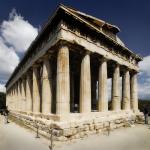|
This section contains 2,037 words (approx. 7 pages at 300 words per page) |

|
Dances of Everyday Life.
"Anyone who cannot sing and dance in a chorus is uneducated," stated Plato in the Laws, which is a blunt reminder that dance was part of Greek education. Dances played a large role in everyday life. They belonged to folk tradition, and they often had a religious or semi-religious basis. Mourners danced at funerals. They can be seen on vase-paintings, in long rows with hands placed on top of their heads in a gesture of grief. There were also wedding dances. There was no wedding ceremony as there is in the Christian church, but after the families of the bride and groom had worked out the details of the marriage agreement, a chorus of young men and women escorted the bride and groom to the groom's house with dance and song. There were usually two choirs—one of men and the other...
|
This section contains 2,037 words (approx. 7 pages at 300 words per page) |

|




